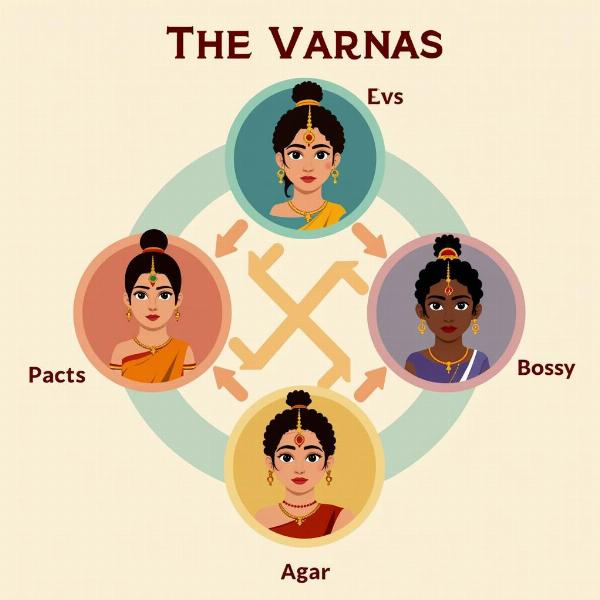The term “jaati meaning in hindi” often translates to “caste,” but the concept holds much deeper cultural and societal significance than a simple translation can convey. Understanding its nuanced meanings is crucial for grasping the complexities of Indian society. This article delves into the different facets of “jaati,” exploring its historical roots, social implications, and evolving interpretations in modern India.
The Historical Roots of Jaati
The origins of the caste system are complex and debated. Some theories link it to the arrival of Indo-Aryans and the subsequent development of the varna system, a four-fold social hierarchy consisting of Brahmins (priests), Kshatriyas (warriors), Vaishyas (merchants), and Shudras (laborers). Over time, this system evolved into the more intricate and rigid jaati system, with numerous sub-castes emerging within each varna. Historically, jaati determined one’s occupation, social status, and even marriage prospects. Traditional Hindu scriptures and texts often reinforced these social divisions, contributing to the system’s persistence.
 Historical Roots of Jaati in India
Historical Roots of Jaati in India
Jaati in Modern India: Evolution and Challenges
While the caste system remains a significant factor in Indian society, its influence has been challenged by modernizing forces and legal reforms. The Indian Constitution enshrines the principle of equality and prohibits caste-based discrimination. Affirmative action policies have attempted to address historical injustices and empower marginalized communities. Despite these efforts, caste-based inequalities persist in various forms, including access to education, employment, and social mobility.
Social Implications of Jaati
Jaati continues to influence social interactions and relationships in India. Endogamy, or marriage within one’s own caste, is still prevalent, although inter-caste marriages are becoming more common, especially in urban areas. Social gatherings, religious practices, and even political affiliations can be influenced by caste identities. Understanding these dynamics is crucial for navigating social landscapes and promoting inclusivity.
Different Interpretations of Jaati
The concept of jaati is not monolithic. Different schools of thought and social groups interpret it in various ways. Some view it as a divinely ordained system, while others see it as a social construct that has been manipulated and misused over time. Understanding these diverse perspectives is essential for fostering dialogue and promoting a more nuanced understanding of this complex issue.
Jaati and Identity: A Complex Interplay
For many individuals, jaati remains an integral part of their identity, shaping their sense of belonging and community. This can be a source of both pride and prejudice, depending on the context and individual experiences. Navigating this complex interplay of identity and social hierarchy requires sensitivity and awareness.
Conclusion: Navigating the complexities of Jaati in Hindi
Understanding “jaati meaning in hindi” goes beyond a simple translation. It involves grappling with the historical, social, and cultural dimensions of this complex system. While legal reforms and social change are gradually challenging traditional hierarchies, jaati continues to shape Indian society in significant ways. By fostering open dialogue and promoting greater understanding, we can work towards a more equitable and inclusive future.
FAQ:
- What is the difference between varna and jaati? Varna refers to the broader four-fold classification, while jaati refers to the more specific sub-castes within each varna.
- Is the caste system still prevalent in India? While legally prohibited, caste-based discrimination and inequalities persist in various forms.
- What are the social implications of jaati? Jaati can influence marriage prospects, social interactions, access to resources, and political affiliations.
- How is jaati viewed in modern India? Views on jaati vary, with some defending it as a traditional system and others criticizing it as a source of inequality.
- What is the role of education in addressing caste-based discrimination? Education can play a crucial role in raising awareness, challenging prejudices, and promoting social mobility.
- What are some initiatives to promote equality among castes? Affirmative action policies and social awareness campaigns are some examples.
- How does jaati intersect with other forms of identity? Jaati can interact with religious, regional, and linguistic identities, creating complex social dynamics.
Related Articles:
- social evils meaning in hindi
- strain meaning in hindi in physics
- bog meaning in hindi
- crush love meaning in hindi
Meaning-Hindi.in is your trusted partner for high-quality Hindi translation services. We specialize in various translation domains, including business, legal, technical, website localization, educational, and specialized content. Our team of expert linguists ensures accurate and culturally sensitive translations, tailored to your specific needs. For all your Hindi translation requirements, contact us at [email protected] or call us at +91 11-4502-7584. Meaning-Hindi.in is dedicated to bridging language barriers and fostering effective communication.